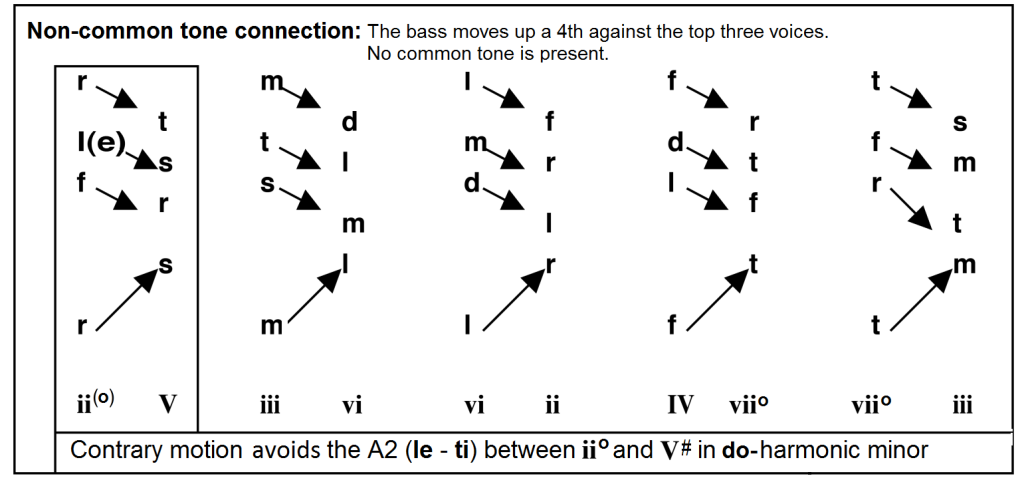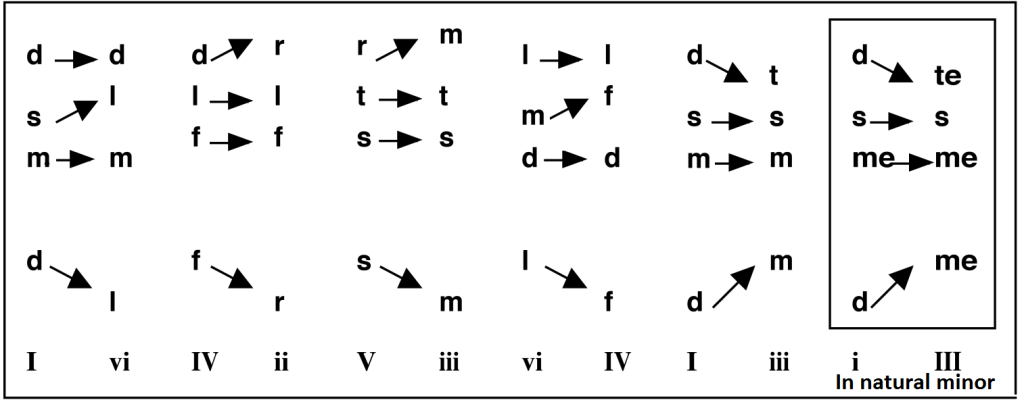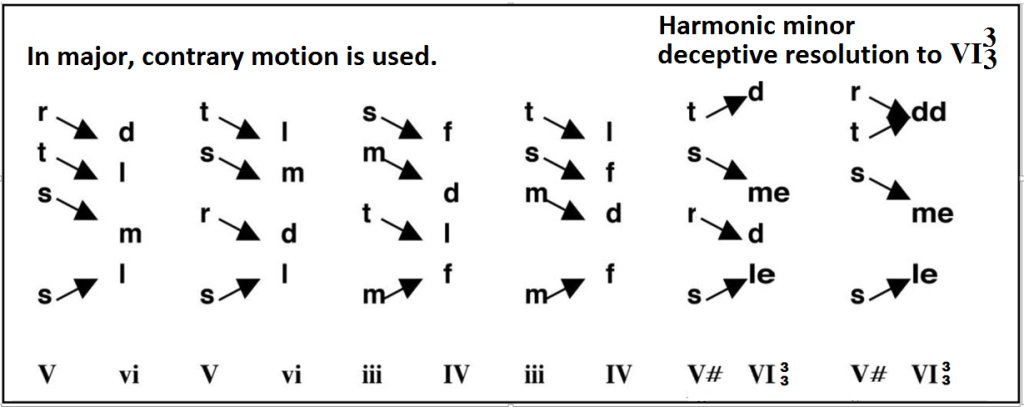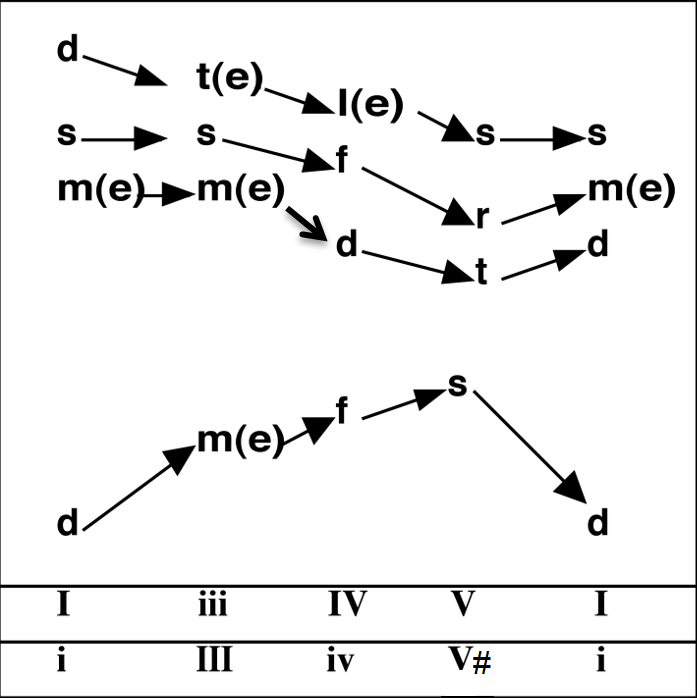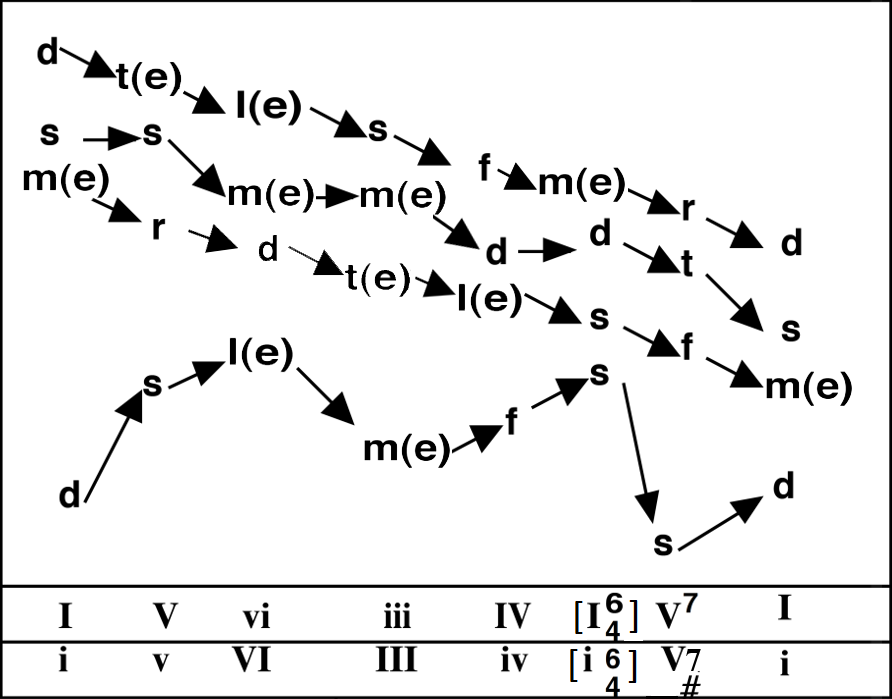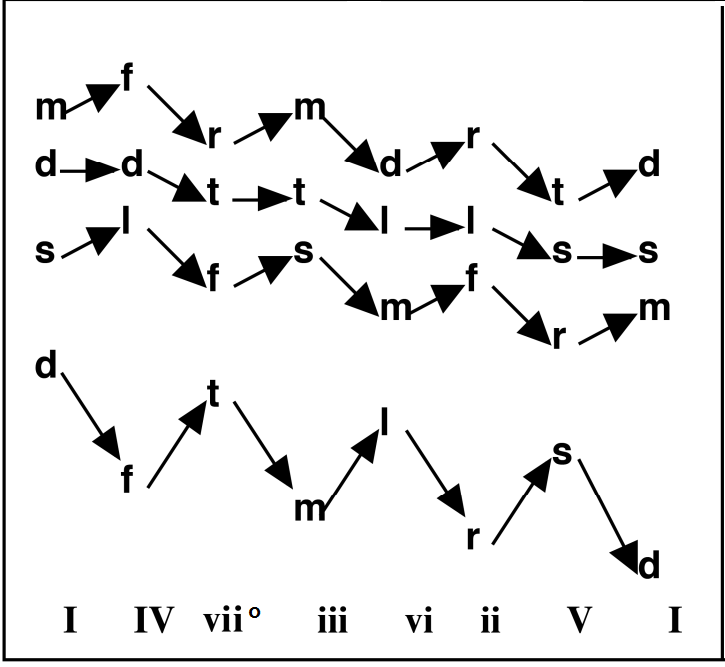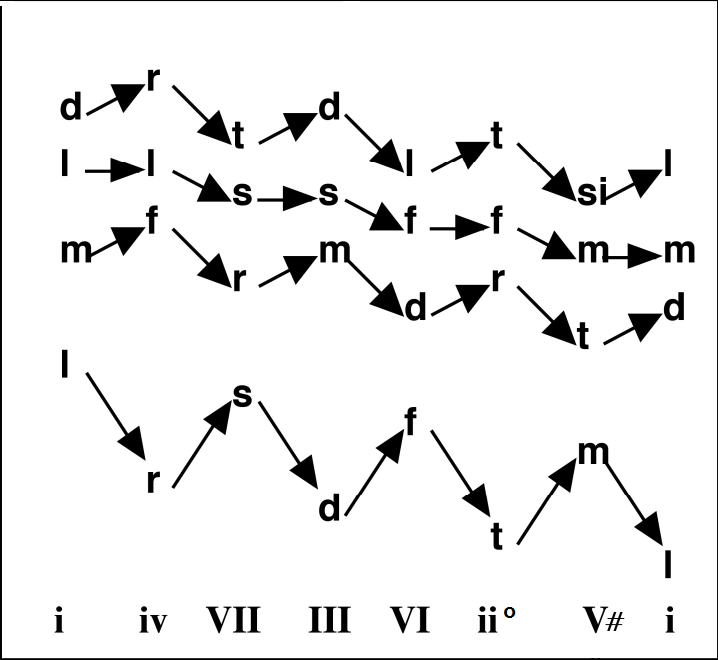7 Secondary Triads in Root Position
Connecting root position primary and secondary triads
The connections between primary and secondary triads are governed by the intervallic movement of their roots.
- The falling 5th root progressions imitate the V – I resolution in a dominant-like manner.
- The falling 3rd root progressions extend the tonic (I – vi), subdominant (IV – ii), and dominant (V – iii) triads.
- The rising 2nd root progressions imitate the motion of IV – V.
Major |
Minor |
|
| Falling 5th |
V – I I – IV ii – V iii – vi vi – ii IV – viio * viio – iii * * as part of the diatonic sequence |
v or V i – iv iio – v or V III – VI III+ – VI VI – iio iv – VII VII – III mostly in natural minor |
| Falling 3rd |
I – vi IV – ii V – iii vi – IV I – iii (rising 3rd exception) |
i – VI iv – iio VI – iv i – III (rising 3rd in natural minor) |
| Rising 2nd |
IV – V V – vi iii – IV I – ii (less frequent) |
iv – V V III – iv i – iio |
The reverse of the above root movements is a retrogression and is used infrequently in music of the Common Practice. Modal music typically employs such backward movements.
common uses of secondary triads
The supertonic (ii) triad
- Substitutes or prolongs the subdominant IV triad.
- Normally resolves to V in a falling 5th movement.
The submediant (vi) triad
- Substitutes or prolongs the I triad. See the chapter on Deceptive Resolutions/Cadences.
- Normally resolves to ii in a falling 5th movement or to IV in a falling 3rd movement.
The mediant (iii) triad
- Substitutions: V – vi becomes iii – vi, and I6 – IV becomes iii – IV
- Normally resolves to vi in a falling 5th movement. Can also resolve to IV in a rising 2nd movement.
- In harmonic minor the III+ triad resolves to VI.
The leading tone (viio) and subtonic (VII) triad
- The viio triad rarely appears in root position due to the doubled leading tone, except in the diatonic sequence where it does not function as a dominant-type chord.
- In natural minor, the VII triad is a major triad. It typically resolves to III. The VII – III in minor sounds like V – I in the relative major, and often is employed by composers to hint at the relative major key while remaining in a minor key. For a good example, listen to the diatonic sequence in minor.
Voice Leading
Common tones
- Roots a 5th apart have one common tone; use common tone or non-common tone connection
- Roots a 3rd apart have two common tones; use common tone connection
- Roots a 2nd apart have no common tones; use contrary motion
Doubling
- Primary and secondary triads in root position normally double the root (the bass).
- Recall that the [I
 ] chord has a doubled 5th in anticipation of resolving to the V chord.
] chord has a doubled 5th in anticipation of resolving to the V chord.
1. Roots a 5th apart (one common tone between chords)
(a) Common tone connection
*The irregularly doubled root in viio is acceptable when followed by the III chord. When used as a dominant type chord moving to the tonic, the viio chord is found in first inversion (see Secondary Triads in First Inversion).
When using iio – V![]() in minor, avoid le moving up to ti, as it creates an unattractive melodic augmented second (A2). Instead use non-common tone connection.
in minor, avoid le moving up to ti, as it creates an unattractive melodic augmented second (A2). Instead use non-common tone connection.
(b) Non-common tone connection
2. Roots a 3rd apart (two common tones between chords)
The primary triads are extended by their relative minor secondary counterparts.
3. Roots a 2nd apart (no common tone between chords)
Movement between chords that are a 2nd apart imitate the contrary motion between IV – V.
*In harmonic minor, V![]() – VI in contrary motion produces an incorrect A2 between ti – le. To avoid the A2, double the 3rd of the VI
– VI in contrary motion produces an incorrect A2 between ti – le. To avoid the A2, double the 3rd of the VI ![]() in harmonic minor.
in harmonic minor.
**The V![]() – VI
– VI ![]() with ti – do and re – do avoids the A2.
with ti – do and re – do avoids the A2.
common progressions using secondary triads in root position
4. Descending major and natural minor tetrachord (d – t – l – s) harmonized
At cadences in natural minor, use the dominant chord from harmonic minor.
5. Descending major and natural minor scales harmonized with diatonic triads
6. Submediant to tonic
The tonic normally is followed by the functionally weaker submediant chord (I – vi or i – VI). Occasionally, however, the reverse occurs (vi – I6 or VI – i6) with the bass moving from l(e) to m(e).
7. The Imperfect Circle of Fifths
The most common diatonic sequence is the falling 5th progression that is transposed diatonically down by a step. (A sequence is a musical pattern, typically comprised of two chords, that is repeated on successive higher or lower pitches. After hearing two or three patterns, the sequence is recognizable.)
The result is a progression of chords based on consecutive falling fifths, creating the strongest harmonic movement in the tonal system.
The sequence is called the imperfect circle of fifths due the presence of the d5/A4 interval (tritone) between fa – ti.
Major |
Minor |
|
I – IV – viio – iii – vi – ii – V – I do – fa – ti , – mi – la, – re – so, – do |
i – iv – VII – III – VI – iio – V la – re – so – do – fa – ti, – mi – la, Chords are from natural minor except for the |
The bass line is a zigzag of falling fifths and rising fourths movements to avoid large skips in the same direction. Note the quasi “dominant” root motion and the sequential alternating of common and non-common tone connections. The root of the viio triad (ti) is doubled irregularly to maintain the sequential pattern.
The imperfect circle of fifths sequence can be translated into natural minor by considering the vi chord of the major key as the i chord in natural minor. Raise the leading tone of the V chord (si in la-minor) to produce a harmonic minor cadence. The syllables below utilize la-minor. (See discussion of la-minor in Diatonic Melodic Drills – La Minor.)
Note that in natural minor the VII, III, and VI chords produce a temporary touch of the relative major key.
A summary of short progressions that form the basis of much of tonal music
MAJOR |
MINOR |
|
I – IV – V – I |
i – iv – V |
|
I – IV – ii – V – I |
i – iv – iio – V |
|
I – vi – IV – V – I |
i – VI – iv – V |
|
I – vi – ii – V – I or iii – vi – ii – V – I |
i – VI – iio – V |
|
I – vi – IV – ii – V – I |
i – VI – iv – iio – V |
|
I – iii – IV – V – I |
i – III – iv – V i – III+ – VI – iv – V |
|
I – V – vi – iii – IV – [ I |
i – v – VI – III – iv – [ i |
|
I – vi – iii – IV – ii – V – I |
i – VI – III – iv – iio – V |
Also see the chapters on Diatonic Sequences.
Practice 2
Complete the left hand accompaniment by continuing the diatonic sequence. The pattern provided in the first two measures descends by step. Alternate common tone and non-common tone connection. The left hand is four-part harmony an octave lower and the right hand melody is an added fifth voice. Provide full analysis.

